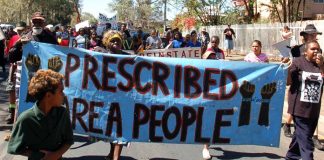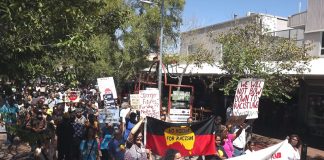The federal government has just concluded a round of “consultations” with Aboriginal communities in the NT about the future of the Intervention. Labor is committed to the key features of the Intervention. Their Stronger Futures discussion paper, released in the week before the consultations, outlines their plan to continue to deny Aboriginal people any control over their communities and to keep stripping resources away from the overwhelming majority of communities. But as we’ve reported previously in Solidarity, many of the consultation meetings have been important sites of protest. Meredith Davies, an Aboriginal rights activist living in Darwin, attended the Darwin meeting and reported for Solidarity.
There have been mixed reviews of the consultations across the Top End. Dr. Djiniyini Gondorra of Elcho Island called for a complete boycott of all consultations until the government formally apologised for the failings of the Intervention and acknowledged the hurt it has caused. Many communities reported that they were not adequately informed of the dates. Some consultations were rescheduled due to a small turnout; a reflection that many have lost faith the government will actually listen.
However, for the public meeting in Darwin, numbers exceeded expectations, with approximately 80 people filing into a room that catered for half that amount.
The government facilitator opened the meeting with an acknowledgement that the Intervention had caused pain, but this was quickly followed by assertions that the Intervention had largely been a success and the consultations were trying to find ways to build on this success. There was clear anger in the meeting about this attitude.
People slammed the Stronger Futures discussion paper as “suffering from a Mal Brough mindset”. While making inflammatory generalisations about Aboriginal dysfunction, the paper refuses to acknowledge that most Aboriginal people care deeply for their families and that they too see education and employment as priorities.
Many speakers described how the stigma and social engineering of the Intervention has created a sense of hopelessness and disempowerment.
Much of the discussion throughout the meeting linked in with the interconnected issues of the defunding of homelands and restrictions on bilingual education. The NT government introduced regulations in 2008 that mandate teaching in English for the first four hours of every day, effectively abolishing bilingual programs operating in 15 remote NT government schools.
People spoke passionately about the right to live on homelands and birthright to education in their mother tongue. Many pointed to statistics proving better health of Aboriginal people living on homelands. It was argued that schooling on homelands should be supported and that general education systems will not work for remote communities.
There were calls for locally designed curriculum with input from elders and community, with the option of teaching in language to better engage community and students. With proper training, this could provide essential community employment. One speaker said, “falling school attendance is not an Aboriginal issue, it is seen across the board when the content is not seen as relevant”.
In the old days of bilingual education, “Aboriginal teachers worked alongside Balanda (non-Aboriginal) in partnership. Under the first four hours policy, Aboriginal teachers have gone back to being teachers aides, carrying out more menial tasks. There needs to be real employment for the teacher aides”.
“Hub towns” are the 20 communities selected by government for ongoing investment as resources are stripped from most communities and homelands. “Hub towns as refugee camps” was a common analogy, in which people from all over are thrown together diluting the kinship system, language and connection to country. It was argued that growth towns as well as changes to bilingual education are a form of “mainstreaming” or assimilation.
The Strategic Indigenous Housing and Infrastructure Program (SIHIP) was harshly criticised with claims that, “money went to contractors, demountables, Traditional Owners, everything except housing”.
People argued that workers had been imported from interstate at huge cost, rather than recruited locally and given proper training. There was much anger with the government’s ultimatums that long-term township leases are required to get substantial services. Even more outrageous is the fact that the rent on many leases is being paid by Aboriginal people themselves through the Aboriginal Benefits Account.
It was unanimously agreed that urgent action must be taken to remove the “Prescribed Area” signs that label a community as dysfunctional right from the front gate. The meeting erupted when it was said that if communities do not like the signs they could take them down themselves.
People yelled, “You put them up, you take them down” and “It’s about ownership, you need to own that”. Speakers demanded the government take down the signs, apologise for the pain they caused and then offer to repaint friendly signs that existed before, that welcomed people to communities.





